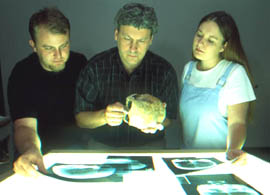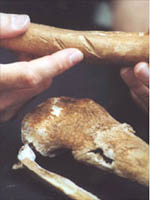Professor, Students Decipher Evidence Left in Skeletal Remains

Each day when Dr. Keith Jacobi goes to his office and into his nearby laboratories, human skeletal remains surround him. And while The University of Alabama assistant professor of anthropology said he understands why some would find such a work setting disturbing, he does not.
Forgetting these unidentified remains are all that is left of someone’s brother, husband or daughter is not the key to dealing with what surrounds him, Jacobi said, remembering is. “He or she is a person,” Jacobi said in reference to the partial skeleton lying on a tray in front of him. “It’s not gross, because I’m trying to find out who this person is.”
As curator of human osteology with UA’s Alabama Museum of Natural History, Jacobi oversees a collection of bones, many of which are part of active, ongoing law enforcement investigations. “This is a repository for unidentified skeletal remains,” Jacobi said.
Drawing on his biological anthropology research work refined by years of fieldwork and skeletal analysis in places like India, Peru, Barbados, and throughout the United States, Jacobi now also serves as a resource for the state’s forensic laboratories, assisting them in identifying remains in homicide and other death investigations.

By analyzing bones, Jacobi can offer clues as to the age, sex, ethnicity, stature and sometimes even the occupation, health or cause of death, of the person authorities are attempting to identify.
The presence or lack of molars, for example, can offer hints of a person’s age as can ridges in the pubic portion of the pelvis. People who suffer from anemia, syphilis, tuberculosis or certain dental diseases also leave behind evidence of those problems in their skeletons. Certain occupations — everything from baseball pitchers, to dancers, to unloaders of trucks — undergo repetitive stress to their bodies, enough to leave enduring marks on their remains, he said. And, in relation to one homicide investigation, Jacobi pointed out that a sharpened screwdriver stabbing makes a different impression in the bone than would a knife.
Seven undergraduate and graduate students work with Jacobi and — thanks to the affiliation with law enforcement investigations — these students are given more in-depth and frequent insight into forensic work than is available to most undergraduates. “We train students how to do skeletal analysis,” Jacobi said. “They can get a fragment and be able to tell what part of the body it came from.”
Whether these students end up being anthropologists, surgeons or forensic scientists, this training can give their careers a boost. And at the same time, it assists law enforcement while bringing closure for the victim’s family. “It’s the last thing anybody can do for them.”